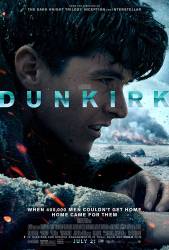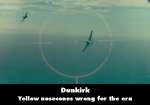Corrected entry: No soldiers in this film were smoking cigarettes - unbelievable for 1940.
Corrected entry: At one point they pan in on Harry Stiles after being wet and the water dripping from his head is white, due to the product in his hair.
Correction: Brylcreem hair gel - practically compulsory for men in those days (and well into the Fifties and Sixties, too). When washed out it turned a milky white - so they may have used the real thing in the film itself.
Corrected entry: All the soldiers are clean shaven despite their current predicament. (01:01:05)
Correction: It was policy to be clean shaven at all times, even during times of battle. Source: I use to do 82nd Airborne reenactment.
Corrected entry: In the scene at the end of the film featuring a Spitfire that has run out of fuel, we see the plane with the propeller stopped but in the next shot, it's slowly rotating. The next shot shows it stopped again but in the next shot, it's (once again) slowly rotating.
Correction: The prop would stop but would possibly move due to the forward motion of the aircraft and air flow.
Corrected entry: When the Spitfire ditches in the Channel, it floats for a while. Most unlikely. The Merlin engine weighed over three quarters of a ton and would have dragged the aircraft down almost immediately.
Correction: It doesn't matter what the engine weighs, it depends upon how much water the entire aircraft displaces. The physics don't need arguing about. On June 1 1940 Jack Potter ditched his Spitfire in the Channel during the Dunkirk evacuation. It stayed afloat long enough for him to climb out of the cockpit and wait for the French fishing vessel La Jolie Mascotte to pick him up more than eight minutes later. It happened, so it's possible.
Corrected entry: As the last Spitfire runs out of fuel, it continues to fly along the beach; then apparently turns around and flies the opposite direction along the beach still maintaining his steady low altitude. This is an impossible feat as distance flown (and any turn without power) results in loss of altitude.
Correction: While the flight dynamics in the final scene are improbable (especially shooting down the Stuka), altitude and manoeuvres are a function of energy, of which height (potential energy) are just one component. You could fly level along the beach, slowing down trading speed (kinetic energy) to maintain height, execute the turn trading more speed to execute the manoeuvre, then fly in the other direction to land on the sand. This is demonstrated in real life footage (searchable on the internet) of Bob Hoover flying his Aero-Commander dead stick in level flight at an air show, executing an 8 point roll and then turn, and flying/gliding back to land.
Corrected entry: Generally the clothes are not 100% of WWII. We see a lot of hats and head protection which didn't exist at that time. Also the holsters for the side guns were all closed and not open like in the movie.
Correction: I didn't notice any headgear that was inaccurate. In fact, many servicemen did use open holsters, especially vehicle and aircraft crews.
Corrected entry: At the beginning of the movie, there is a timber factory with nice timber on a lot of staples, this is something that was not possible at that time of the war. All the timber had been used.
Correction: That's just ridiculous. They still made timber at timber factories and they need wood for that, which is stacked at the factory. It's not like all wood gets shipped to the war the moment the tree is cut down. People still need furniture, doors, housing, boats. Life goes on during a war.
Corrected entry: When the 2 actors are carrying the injured soldier to the ship, when crossing the sand, the camera tracks are visible behind them.
Correction: That's a Steadicam shot which requires no dolly tracks. What you can see is the wrecked and partially buried light railway tracks leading to the mole, visible in photographs taken during the evacuation and cleverly restaged here.
Corrected entry: When asked whether he had a gun, Cillian Murphy says he had a .303. As an officer (his shoulder strap shows the insignia of a British Second Lieutenant), he would have carried a pistol but not a rifle. It was not until later in the war that British officers began to carry weapons other than sidearms, and even then it was usually SMGs and not rifles.
Correction: With all the fighting he could have easily run out of ammo for his pistol (or lost the pistol) and picked up a .303 to continue fighting. Saying he had a .303 is not the same as claiming he was issued a.303.
Corrected entry: We see the Royal Navy requisitioning small boats in harbour and crewing them with naval personnel. Rather than wait for this to happen, Mark Rylance decides to set sail for Dunkirk himself. However, when the flotilla of other small craft are seen, none of them are crewed by navy personnel.
Correction: A large number of the little ships were manned solely by civilians due to a lack of Naval personnel. And in fact, we see several of them manned by naval crews.
Corrected entry: Commander Bolton addresses the rear-admiral by his full rank. In fact, he would undoubtedly just address him as "Admiral", the courteous form of address for all flag officers.
Correction: A rear-admiral can be referred to as such. It is not technically incorrect.
Corrected entry: When the 2 men carry the stretcher on the beach early in the morning, one can see the tracks left in the sand by the camera buggy.
Correction: This is a duplicate of an entry which has already been corrected. To quote that correction, "That's a Steadicam shot which requires no dolly tracks. What you can see is the wrecked and partially buried light railway tracks leading to the mole, visible in photographs taken during the evacuation and cleverly restaged here."







Correction: While it might be unbelievable for soldiers to not be smoking cigarettes in 1940, this is only an opinion and not a mistake. At the time of Dunkirk, the British Expeditionary Force was in short supply on everything, to include rations (cigarettes were issued to the soldiers via their rations). The shortages were emphasized at the very beginning of the movie where we see soldiers scrounging; i.e. draining water from a hose for something to drink, reaching through an open window to sort through an ash tray for a possible smoke. As stated by the senior British Military officers on the beach, the British leadership was saving what military resources they had for the next/future battles. The focus at Dunkirk was evacuation, not re-supply. The bottom line, you can't smoke 'em, if you ain't got'em.